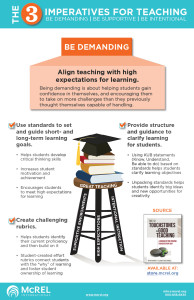
Being demanding is one of three key characteristics of effective teachers, along with being intentional and being supportive, that are discussed in McREL’s The 12 Touchstones of Good Teaching. Being demanding is not about being a no-nonsense, authoritarian teacher. It’s about having high expectations of your students and, just as importantly, helping them gain confidence in themselves and encouraging them to take on more challenges than they previously thought themselves capable of handling.
The 12 Touchstones book gives four key things for teachers to think about within the be demanding imperative. It’s good to reflect on these throughout the school year, and self-assess how you’re doing:
- I use standards to guide every learning opportunity.
- I ensure students set personal learning objectives for each lesson.
- I peel back the curtain and make my performance expectations clear.
- I measure understanding against high expectations.
To be demanding, a teacher needs to use the district-approved standards to explicitly explain the learning, help students set and expand goals, develop challenging rubrics, and set high expectations. The benefit to challenging students this way is helping them develop critical-thinking skills they’ll need and use throughout their lives. A demanding and highly effective teacher increases students’ motivation and achievement by supporting and encouraging them in meeting high expectations.
Teachers should guide students’ learning by unpacking the standard and looking for big ideas and opportunities for creativity. The teacher should also provide structure and guidance to clarify the learning for the students. One way to help students clearly understand the learning objective is to have them help write the “I Can” or “Know, Understand, and Be Able to Do” (KUB) statements based on the standards. The statements should be posted so students can easily refer to them during instruction and teachers should reference them throughout the lesson.
We all feel good about ourselves and gain confidence when we achieve goals that we set for ourselves. It is imperative for students to set short- and long-term personal learning goals to feel successful about their education. Teachers can provide goal-setting forms to students so that they have goals written down and know exactly what they must do to achieve them. It’s crucial for teachers to help students tie the goals to the standards and learning objectives so they understand the “why” behind their learning.
Student-created rubrics are excellent for providing performance expectations and criteria. Teachers can create their own, but better yet, when students have a hand in creating rubrics, they also have ownership and understanding. Teachers can help the students identify the proficiency level and then build the rubric around it. Examples of previous students’ work should be provided to help students make the connection between the rubric criteria and the example.
A highly effective teacher sets and communicates high expectations and provides opportunities for students to challenge themselves through appropriate assessments, feedback, and deepening their critical-thinking skills. Collaborating with students to create an effort rubric is an excellent way for students to make the connection between their effort and success. It is important to go one step further and have the students track the effort rubric with their achievement rubric to help them understand the level of effort it will take to meet their goals.
My daughter ended up flourishing in Mr. Bagley’s class, and even now, years later, she says Mr. Bagley is her all-time favorite teacher. He believed in the students and demanded that they do their best, as he would do his best for them. As my daughter told me, “When a teacher has faith in their students, sets high expectations, and has a desire for them to succeed, students rise to meet the goals set before them.”
In this blog post series, I will address each of the three imperatives presented in The 12 Touchstones of Good Teaching: A Checklist for Staying Focused Every Day. Look for my next post on ways to be supportive.

Even the most dedicated and experienced teachers can benefit from having a strategic checklist to boost their effectiveness. What are the 12 simple but essential things you can do every day to deliver high-quality instruction and positively impact student outcomes? Bryan Goodwin and Elizabeth Hubbell reviewed thousands of research studies, books, and articles to supply the answer in The 12 Touchstones of Good Teaching: A Checklist for Staying Focused Every Day. In addition to identifying the 12 touchstones, the authors also define three key imperatives for quality teaching and learning—be demanding, be supportive, and be intentional—and offer strategies for integrating them into classroom practice. Order The 12 Touchstones of Good Teaching from the McREL Bookstore. Learn more.

